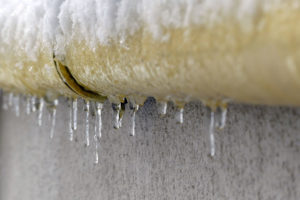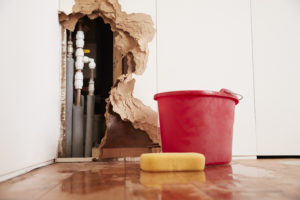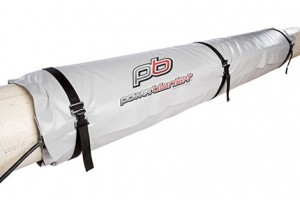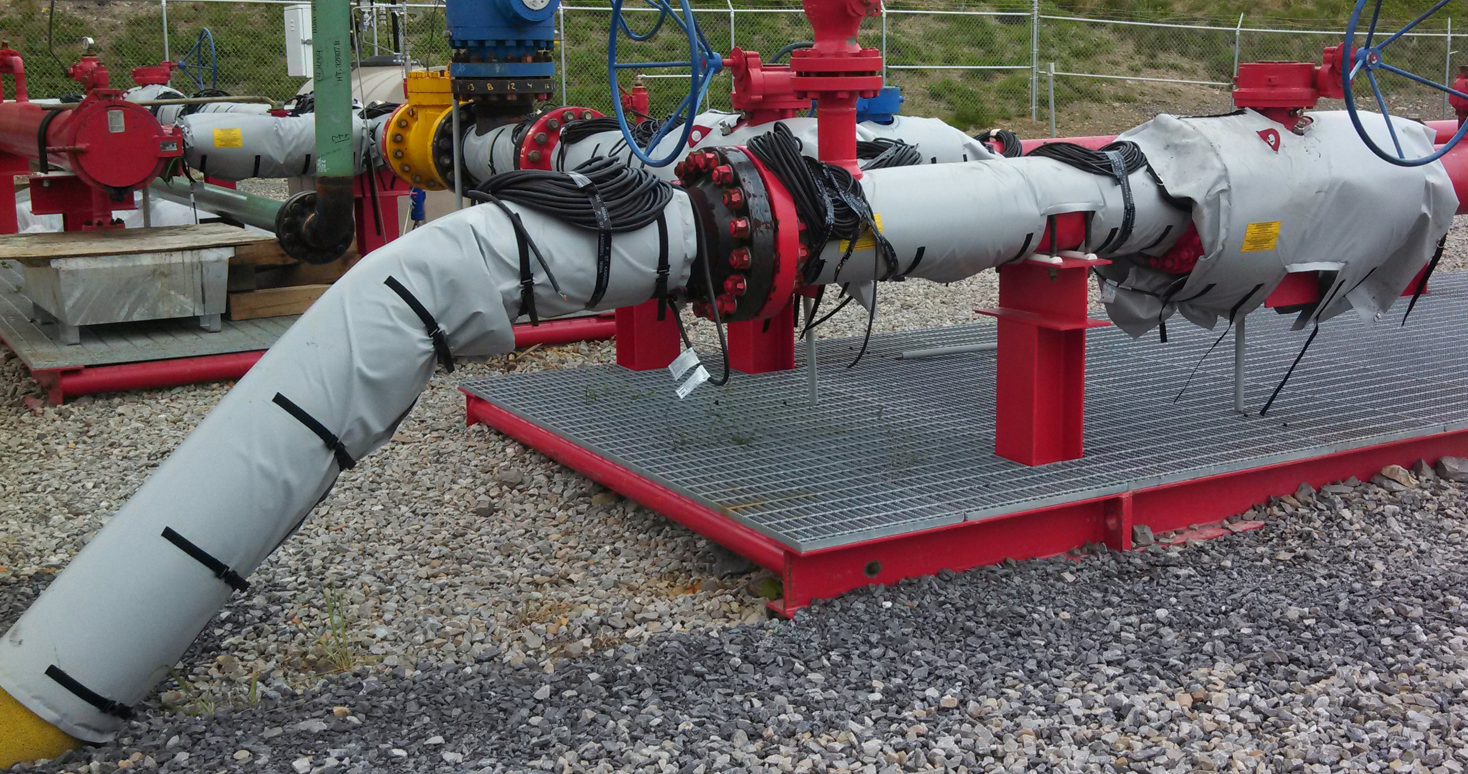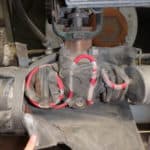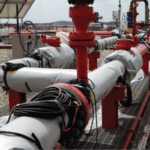What causes frozen pipes to burst?
During the winter, the average temperature is typically very low in some parts of the nation. This colder temperature creates a situation where water freezes inside the pipes and leads to frozen pipes, which can then lead to burst pipes. When water is frozen and expanded, it creates pressure on lines and can cause them to burst. It is, therefore, crucial that homeowners take proactive steps when winterizing plumbing. These preventative measures will prevent frozen pipes and subsequent issues when pipes burst during cold weather.
Common Questions About Frozen Pipes
At What Temperature do pipes freeze?
Freezing can take place at temperatures as low as 20°F (-6°C) or lower. The exact temperature at which pipes will freeze depends on various factors, including the type of material the pipes are made of, the insulation of the lines, the velocity of the water flowing through the lines, and the surrounding air temperature. For example, copper pipes are less likely to freeze than plastic pipes, and lines that are properly insulated and located in heated spaces are less likely to freeze than those located in unheated spaces. It is important to take measures to protect pipes from freezing in cold weather, such as adequately insulating pipes and allowing a slow flow of water through the lines to prevent damage and potentially costly repairs.
Can pipes burst when they are thawing?
Yes, pipes can burst when they are thawing. The risk isn’t only there when the temperature drops initially. When water pipes freeze, the water inside expands and puts pressure on the pipes. If the frozen pipes are not thawed properly, the pressure can cause the pipes to burst when they finally thaw. This is why it’s important to take precautions to prevent pipes from freezing in the first place and to thaw frozen pipes if they do occur properly. To thaw frozen pipes, it’s best to start by slowly warming the pipes using hot water or a heating pad. Avoid using an open flame or another heat source that could cause the pipes to overheat and burst.
Do Pipes Always Burst When They Freeze?
No, not all pipes will burst when they freeze. The likelihood of a pipe bursting depends on several factors, including the type of material the pipes are made of, the size of the pipe, the pressure of the water inside the pipe, the water pressure, and the degree to which the pipe is frozen. Insufficient insulation and extreme cold lead to frozen pipes that are more likely to have a problem as those water molecules freeze and water expands.
For example, larger pipes and pipes made of more durable materials are less likely to burst than smaller or more brittle pipes. Additionally, pipes that are properly insulated and located in heated spaces are less likely to freeze and burst than those located in unheated spaces. However, even with these factors in mind, it’s still possible for pipes to freeze and burst, so it’s important to take precautions to prevent pipes from freezing and thaw them if they do freeze properly.
Are northern Climates More Prone To burst pipes?
Yes, climates in the north are generally more prone to have frozen pipes burst due to freezing temperatures. In areas with cold winters and low temperatures, water pipes are at a higher risk of freezing and bursting. This is because the colder the temperature, especially in subfreezing weather, the more likely the water inside the pipes is to freeze, which can put pressure on the pipes and make it more likely that a frozen pipe bursts.
What to do when frozen pipes burst?
If the ice is still there, you can thaw it yourself to prevent it from bursting. There should be an exact place to freeze pipes. It is sometimes extremely challenging as the frozen parts of pipes typically lie underneath walls, behind building insulation, or in crawl spaces. If there are no signs of where the frozen pipes burst, contact the plumber immediately. Use an air-tightening pad, hot towel, tin, and hot dryer. Never use boiling water for ice in pipes! The thaw is so quick that the ice breaks off the surface. Changing water quickly will have an impact causing it to burst if it has already happened. It is possible to heat up the house with warm towels and t-shirts or with a space heating device.
What to do with burst pipes?
If pipes burst, it’s essential to take immediate action to minimize damage and prevent further damage. Here are some steps to take to address a frozen pipe:
- Turn off the water supply to the frozen pipe: The first step is to turn off the main water supply to the affected area. This will prevent water from continuing to flow into the area and causing further damage.
- Locate the frozen pipe: Locate the leak’s source and assess the damage’s extent. Once you know where the pipe’s located, if the leak is not severe, you may be able to turn the water back on and continue to use it until a plumber arrives.
- Contain the water: If possible, use buckets or other containers to prevent water from spreading and causing further damage.
- Call a plumber: Call a licensed and experienced plumber to repair the burst pipe. A plumber will have the tools and expertise to repair quickly and effectively.
- Clean up and dry out the area: Once the repair is made, clean up the area and use fans and dehumidifiers to dry it out to prevent mold and mildew from growing.
It’s important to act quickly and efficiently when frozen pipes burst to prevent further damage and ensure the repair is made as soon as possible.
How to Prevent Frozen Water Pipes | Prevent a ‘Pipe’tastrophe
Avoiding the headache and chaos when frozen pipes burst is easier than you might think. Powerblanket pipe warmers are designed to keep pipes warm and prevent them from freezing and bursting in cold weather conditions. These warmers are made of a heavy-duty, insulated material that provides a consistent and uniform heat source to pipes, helping to maintain a stable temperature around the pipes and preventing frozen pipes.
Powerblanket pipe heaters can be easily wrapped around pipes, making them an ideal solution for preventing pipes from freezing and bursting in various applications. They come in many sizes to accommodate different pipe sizes and are equipped with adjustable temperature controls to ensure the pipes are kept at the desired temperature.
In addition to preventing pipes from freezing and bursting, Powerblanket pipe warmers can also help extend the pipes’ life and prevent damage from thermal cycling. They are ideal for use in outdoor applications and in buildings and structures where pipes are at risk of freezing, such as unheated garages, sheds, and barns.
Powerblanket pipe warmers are an effective and efficient way to prevent pipes from freezing and bursting in cold weather conditions. They are easy to use, reliable, and can help save time and money by reducing costly repairs and downtime caused by frozen pipes.
Pipe heaters from Powerblanket keep your fluids flowing all year long, providing freeze protection for your entire system.


